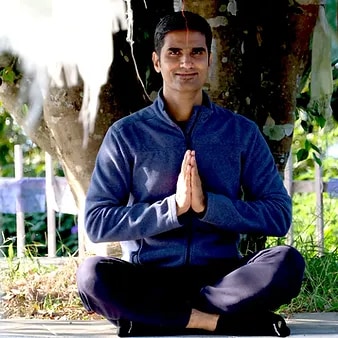The Transformative Power of Mantra Yoga
by Hardik Mehta

Mantra Yoga, an ancient practice rooted in the traditions of Hinduism, Buddhism, and other Eastern philosophies, offers a pathway to spiritual awakening and mental clarity through the repetition of sacred sounds. This unique form of yoga, distinct from the more physically oriented practices, focuses on the power of sound to harmonize the body, mind, and spirit. At its core, Mantra Yoga involves the chanting or intonation of mantras—sacred syllables, words, or phrases—designed to elevate consciousness and promote inner peace.
The Essence of Mantra Yoga
The word “mantra” is derived from two Sanskrit words: “manas,” meaning mind, and “tra,” meaning tool or instrument. Thus, a mantra is essentially a tool for the mind, aiding in concentration and meditation. The practice of Mantra Yoga involves using these sacred sounds to transcend the ordinary thought process and connect with a higher state of consciousness.
Mantras are believed to carry vibrational frequencies that resonate with different aspects of the self and the universe. These vibrations can induce various psychological and spiritual states, helping practitioners align their inner energies with the cosmic forces. The repetition of mantras, either aloud, whispered, or silently, is a form of meditative practice that leads to deep relaxation, mental clarity, and spiritual growth.
Historical and Cultural Significance
Mantra Yoga has a rich historical and cultural heritage. In Hinduism, mantras are considered divine utterances revealed to sages and seers. They form an integral part of various rituals, ceremonies, and meditative practices. The Vedas, ancient sacred texts of Hinduism, contain numerous mantras that are chanted during religious ceremonies and personal meditation sessions.
In Buddhism, mantras are used as tools for mindfulness and enlightenment. The famous “Om Mani Padme Hum” mantra, associated with the Bodhisattva of compassion, Avalokiteshvara, is chanted by millions of Buddhists around the world to cultivate compassion and wisdom.
Jainism, Sikhism, and other spiritual traditions also incorporate mantra chanting into their practices, each with its unique set of mantras and philosophical underpinnings. Despite the differences in religious contexts, the underlying principle remains the same: the transformative power of sound.
The Science Behind Mantra Yoga
Modern science has begun to explore and validate the benefits of mantra chanting. Research in neuroscience and psychology has shown that repetitive sounds and rhythmic patterns can have profound effects on the brain and nervous system. Chanting mantras has been found to reduce stress, lower blood pressure, and enhance cognitive function.
The rhythmic pattern of chanting aligns brain waves, inducing a state of deep relaxation and increased awareness. This synchronization can improve mental focus, reduce anxiety, and promote a sense of inner calm. Additionally, the vibrations produced by chanting can stimulate the vagus nerve, which plays a crucial role in regulating the parasympathetic nervous system, further enhancing relaxation and overall well-being.
The Practice of Mantra Yoga

Engaging in Mantra Yoga involves several key steps to maximize its benefits:
- Choosing a Mantra: The selection of a mantra is a personal and often intuitive process. Some practitioners are drawn to traditional mantras like “Om,” “So Hum,” or “Gayatri Mantra,” while others may choose a mantra given by a teacher or one that resonates with their spiritual goals.
- Creating a Sacred Space: Setting up a quiet, comfortable space for chanting is essential. This area should be free of distractions and supportive of meditation.
- Posture and Breathing: Sitting in a comfortable position with an erect spine helps maintain focus and allows for optimal breath control. Breathing deeply and rhythmically enhances the chanting experience.
- Repetition and Rhythm: The mantra can be chanted aloud, whispered, or repeated silently. Using a mala (a string of 108 beads) can help keep track of repetitions and maintain concentration.
- Intention and Focus: Holding a clear intention or focusing on a specific goal during the practice can amplify the mantra’s effects. Visualizing the meaning or the deity associated with the mantra can deepen the meditative experience.
Benefits of Mantra Yoga

The benefits of Mantra Yoga are manifold, touching on various aspects of physical, mental, and spiritual health.
- Stress Reduction: The calming effects of mantra chanting help reduce stress and anxiety. The repetitive nature of the practice induces a meditative state, promoting relaxation and mental peace.
- Enhanced Concentration: Regular practice of Mantra Yoga improves focus and concentration, aiding in better cognitive performance and decision-making.
- Emotional Healing: Chanting mantras can help release negative emotions and foster positive feelings of love, compassion, and gratitude. This emotional purification leads to a more balanced and harmonious life.
- Spiritual Growth: Mantra Yoga facilitates a deeper connection with one’s inner self and the divine. It opens pathways to higher states of consciousness and spiritual awakening.
- Physical Well-being: The physiological effects of chanting, such as reduced blood pressure and improved respiratory function, contribute to overall physical health.
Integrating Mantra Yoga into Daily Life
Incorporating Mantra Yoga into daily life can be both simple and profound. Starting with just a few minutes of chanting each day can yield significant benefits. As one becomes more comfortable with the practice, the duration and frequency can be gradually increased.
Morning and evening are particularly conducive times for chanting, providing a peaceful start and end to the day. However, mantras can also be chanted during other activities, such as walking, cooking, or commuting, to maintain a sense of mindfulness and presence throughout the day.
Participating in group chanting sessions or kirtans (devotional singing) can also enhance the experience. The collective energy of a group amplifies the vibrations and creates a powerful sense of community and shared spiritual endeavour.
Mantra Yoga, with its roots in ancient spiritual traditions, offers a timeless practice for modern seekers of peace, clarity, and spiritual growth. By harnessing the power of sound, mantra chanting transcends the ordinary boundaries of the mind, opening doors to profound inner transformation. Whether practiced alone or in a group, for minutes or hours, Mantra Yoga provides a versatile and accessible path to a more centred and enlightened life. As science continues to uncover its benefits, the timeless wisdom of Mantra Yoga remains a testament to the enduring power of sacred sound.
Sayujya Yoga offers 200 Hours TTC and short courses, providing a holistic approach that blends ancient philosophies with a contemporary touch. As a premier Yoga class in Mumbai, Sayujya Yoga stands out as the best yoga institute in Mumbai. Renowned among yoga schools in Mumbai, it offers comprehensive Hatha Yoga Teacher Training in Mumbai and Ashtanga Yoga Teacher Training in Mumbai. With a reputation for the best yoga teachers in Mumbai, their 200 hours yoga training in Mumbai is unmatched. Experience the best yoga teacher training in India at Sayujya Yoga, the best yoga institute in Mumbai.
About the Author

Hardik Mehta
Hardik is an E-RYT 500 & YACEP (Yoga Alliance Continuing Education Provider), Yoga Alliance, USA. He has been practicing yoga for the last 9 years. Prior to finding his true calling in Yoga, he was working with various corporates for 12 years in the Retail and eCommerce sector.
